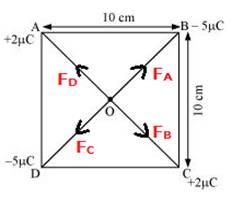Four-point charges qA = 2 μC, qB = –5 μC, qC = 2 μC, and qD = –5 μC are located at the corners of a square ABCD of side 10 cm. What is the force on a charge of 1 μC placed at the centre of the square?
Consider a square of side 10 cm. Four charges are placed in its corners. Let O be the centre of the square.
The diagram is:

AB = BC = CD = DA = 10 cm
Diagonal of a square = √2 × Side of a square
Therefore,
AC = BD = 10√2 cm
AO = OC = DO = OB = (10√2)/2 cm = 5√2cm
i. A charge of magnitude 1μC is placed at O, the centre of the square.
Corner A has a positive charge. The force of repulsion between the charge at A and the charge at the centre, O, will be equal in magnitude and opposite in direction when compared to the force of repulsion between the charge placed at C and charge placed at O. Hence, these two forces will cancel each other.
ii. On a similar note, the force of attraction between the charge kept at D and charge kept at O will be equal in magnitude but opposite in direction to the force of attraction between the charge kept at B and the charge kept at O. These two will also cancel each other.
Therefore, we can conclude that the resultant force by the four charges kept in the corners on the charge that is kept in the centre will be zero.